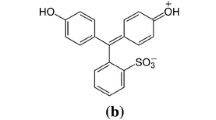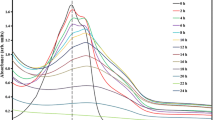Abstract
The simultaneous bimodal study of the photocatalytic oxalic acid degradation by aqueous TiO2 suspensions revealed that particular systems possess the capacity to protect a certain amount of oxalic acid from oxidation, thus hindering, to some extent, the photocatalytic reaction. While measurements of the oxalic acid concentration in the bulk liquid phase indicated full photocatalytic degradation; in situ pH-stat measurements allowed the quantification of the amount of oxalic acid remaining in the part of the nanoparticulate agglomerates where light could apparently not access. An explanation for this phenomenon takes into account the possibility of the formation of TiO2 agglomerates in which these molecules are hidden from the effect of the light, thus being protected from photocatalytic degradation. Studies of different TiO2 materials with different particle sizes allowed a deeper exploration of this phenomenon. In addition, because this property of encapsulating pollutant molecules by photocatalytic systems is found to be a reversible phenomenon, P25 appears to be more convenient and advantageous as compared to the use of large surface area photocatalysts.
Graphical Abstract
Fig.: Deaggregation of TiO2 particle agglomerates upon UV illumination.




Similar content being viewed by others
Notes
The four TiO2 materials were characterized by Rietveld refined powder X-ray diffraction (XRD) for the identification of the constituting polymorph and the calculation of the mean crystalline domain which is usually used as the particle size. The measurements were carried out on a Bruker D4 Endeavour diffractometer (Cu Ka radiation, Ni filtered) at the Institute of Mineralogy of the Leibniz Universitaet Hannover.
The pKa constants at 25 °C and low ionic strength are 1.25 and 4.27 Smith and Martell (1979). Critical stability constants. New York, Plenum Press.
The Langmuir–Freundlich isotherm, i.e., \(y = \frac{{N \times K \times x^{(1 - C)} }}{{1 + K \times x^{(1 - C)} }}\), contains an experimental adjustable parameter C.
References
Ahtee M, Unonius L (1977) Structure of NaTaO3 by X-ray powder diffraction. Acta Crystallogr Sect A Found Crystallogr 33:150–154
Brunelli A, Pojana G, Callegaro S, Marcomini A (2013) Agglomeration and sedimentation of titanium dioxide nanoparticles (n-TiO2) in synthetic and real waters. J Nanopart Res 15:1–10
Carneiro JT, Savenije TJ, Moulijn JA, Mul G (2010) Toward a physically sound structure-activity relationship of TiO2-based photocatalysts. J Phys Chem C 114:327–332
Chen S, Wang L-W (2012) Thermodynamic oxidation and reduction potentials of photocatalytic semiconductors in aqueous solution. Chem Mater 24:3659–3666
Diebold U (2003) The surface science of titanium dioxide. Surf Sci Rep 48:53–229
Ebadi A, Mohammadzadeh JSS, Khudiev A (2009) What is the correct form of BET isotherm for modeling liquid phase adsorption? Adsorpt-J Int Adsorpt Soc 15:65–73
Friedmann D, Mendive C, Bahnemann D (2010) TiO2 for water treatment: parameters affecting the kinetics and mechanisms of photocatalysis. Appl Catal B-Environ 99:398–406
Fujishima A, Zhang X, Tryk DA (2008) TiO2 photocatalysis and related surface phenomena. Surf Sci Rep 63:515–582
Greenwood NN, Earnshaw A (1997) Chemistry of the elements. Elsevier, Oxford
Grimwood DJ, Jayatilaka D (2001) Wavefunctions derived from experiment. II. A wavefunction for oxalic acid dihydrate. Acta Crystallogr Sect A 57:87–100
Henderson MA (2011) A surface science perspective on TiO2 photocatalysis. Surf Sci Rep 66:185–297
Housecroft CE, Sharpe AG (2005) Inorganic chemistry. Pearson Education, Harlow
Ivanova I, Schneider J, Gutzmann H, Kliemann J-O, Gärtner F, Klassen T, Bahnemann D, Mendive CB (2013) Photocatalytic degradation of oxalic and dichloroacetic acid on TiO2 coated metal substrates. Catal Today 209:84–90
Jayatilaka D, Grimwood DJ (2001) Wavefunctions derived from experiment. I. Motivation and theory. Acta Crystallogr Sect A 57:76–86
Kudo A, Miseki Y (2009) Heterogeneous photocatalyst materials for water splitting. Chem Soc Rev 38:253–278
Maurya NS, Mittal AK (2006) Applicability of equilibrium isotherm models for the biosorptive uptakes in comparison to activated carbon-based adsorption. J Environ Eng ASCE 132:1589–1599
Mendive CB, Bredow T, Feldhoff A, Blesa M, Bahnemann D (2008) Adsorption of oxalate on rutile particles in aqueous solutions: a spectroscopic, electron-microscopic and theoretical study. PCCP 10:1960–1974
Mendive CB, Bredow T, Feldhoff A, Blesa MA, Bahnemann D (2009) Adsorption of oxalate on anatase (100) and rutile (110) surfaces in aqueous systems: experimental results vs. theoretical predictions. PCCP 11:1794–1808
Mendive CB, Hansmann D, Bredow T, Bahnemann D (2011) New insights into the mechanism of TiO2 photocatalysis: thermal processes beyond the electron–hole creation. J Phys Chem C 115:19676–19685
Pagel R, Dohrmann JK (2007) Thermochemical study of photoinduced processes at TiO2 nanoparticles in aqueous suspension containing Br- or Cl−. Photodeaggregation and subsequent processes. J Phys Chem C 111:4458–4464
Pettibone JM, Cwiertny DM, Scherer M, Grassian VH (2008) Adsorption of organic acids on TiO2 nanoparticles: effects of pH, nanoparticle size, and nanoparticle aggregation. Langmuir 24:6659–6667
Rangabhashiyam S, Anu N, Nangagopal MSG, Selvaraju N (2014) A novel approach of the modified BET Isotherm towards continuous column study. J Sci Ind Res 73:489–494
Scaife DE (1980) Oxide semiconductors in photoelectrochemical conversion of solar-energy. Sol Energy 25:41–54
Smith RM, Martell AE (1979) Critical stability constants. Plenum Press, New York
Soli AL, Byrne RH (2002) CO2 system hydration and dehydration kinetics and the equilibrium CO2/H2CO3 ratio in aqueous NaCl solution. Mar Chem 78:65–73
Wang C-y, Pagel R, Dohrmann JK, Bahnemann DW (2006) Antenna mechanism and deaggregation concept: novel mechanistic principles for photocatalysis. Comptes Rendus Chim 9:761–773
Wang C, Liu H, Qu Y (2013) TiO2-based photocatalytic process for purification of polluted water: bridging fundamentals to applications. J Nanomater 2013:1
Weisz AD, Garcia Rodenas L, Morando PJ, Regazzoni AE, Blesa MA (2002) FTIR study of the adsorption of single pollutants and mixtures of pollutants onto titanium dioxide in water: oxalic and salicylic acids. Catal Today 76:103–112
Acknowledgments
We want to thank Prof. Thorsten Gesing for the XRD measurements and Dr. Bernhard Dringenberg for the BET measurements. We are especially grateful to Jenny Schneider from the Leibniz Universitaet Hannover and Luis Granone from the Universidad Nacional de Mar del Plata for very useful discussions. The authors gratefully acknowledge Ministerio de Ciencia, Tecnología e Innovación Productiva (MINCYT), Universidad Nacional de Mar del Plata (UNMDP) and Bildungsministerium für Bildung und Forschung (BMBF) for financial support: Project Numbers PICT 2683, EXA 701/14 and 033RC1012C-HyCats, respectively. Special thanks to MINCYT (Arg.) and BMBF (Ger.) for the financial support of the bilateral project AL1209. CBM is a member of the research staff of Consejo Nacional de Investigaciones Científicas y Técnicas (CONICET).
Author information
Authors and Affiliations
Corresponding author
Electronic supplementary material
Below is the link to the electronic supplementary material.
Rights and permissions
About this article
Cite this article
Ivanova, I., Mendive, C.B. & Bahnemann, D. The role of nanoparticulate agglomerates in TiO2 photocatalysis: degradation of oxalic acid. J Nanopart Res 18, 187 (2016). https://doi.org/10.1007/s11051-016-3495-x
Received:
Accepted:
Published:
DOI: https://doi.org/10.1007/s11051-016-3495-x




